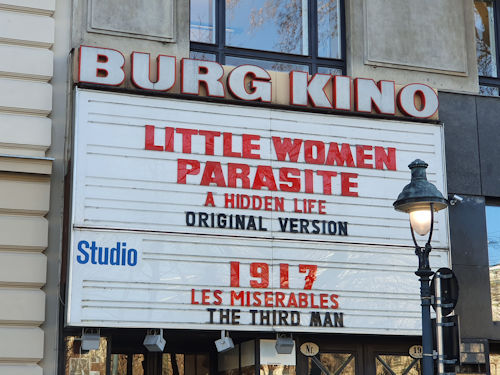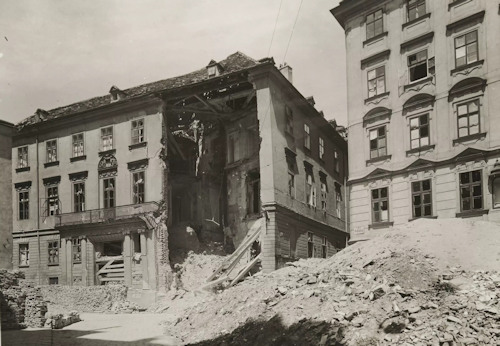Some museums impress with the comprehensiveness of their collection. Some with their expertise. And some with the obvious love for their topic. And some combine all three. Like the Third Man museum.
- Huge collection of film memorabilia and bonus details
- Includes such items as “the” zither
- Clearly collated with care and affection
- Bonus rooms on pre- and post-WWII Vienna
- All in English and German
- Limited public opening days & times
- Join a guided walking tour* around WWII sites & memorials
- See also:
Memorabilia and more

(One side of the museum)
You might imagine you can find a few photos inside the Third Man museum. Perhaps a film poster or two. And maybe an old cinema ticket.
Raise your expectations.
The word memorabilia needs to be even longer to properly describe the hundreds of items within this museum.
You have, indeed, many original movie posters (around 60!) and film stills sent out to cinemas. But also, for example:
- Behind-the-scenes photos
- Original correspondence from the likes of Graham Greene (scriptwriter)
- Around a 100 different editions of Greene’s book
- Original film cameras used during shooting
- Reconstructions (notably of the Ferris wheel cabin scene)
- …and much more

(Such an iconic film that at least one Vienna cinema still has regular showings)
To give you an idea of the comprehensiveness, they even have a small section dedicated to Herbert Halbik. He played the toddler Hansel in the scene where Holly Martins is accused of murdering the porter at Harry Lime’s apartment.
And then we have the breathtaking bits. For example:
- Original scripts (these include Trevor Howard’s copy)
- The chance to watch an excerpt on a 1936 projector
- The zither (complete with cigarette burns) on which Anton Karas performed the iconic theme (see another Karas zither in the historical instrument collection in the Neue Burg)
Let me just say that again…you get to see the actual zither used to perform the movie’s theme.
All of the above is rounded out with further biographical and cinematic details that give you an astonishingly comprehensive picture (pun intended) of The Third Man and those who worked on it.
What perhaps stands out most, though, is the sheer effort that must have gone into accumulating the collection: this is a private museum with no state funding.
Special exhibition
As if that wasn’t enough, part of the museum takes the form of a history exhibition, introducing you to Vienna of the late 1930s and post-WW2 life under the occupying allies. Original clippings, documents, photos, and more from the times illustrate the story.
The displays bring home the miserable state of many people’s lives, the horrors of displacement and Nazi rule, and the devastation wreaked on the city. All with a forthright detail you probably won’t find elsewhere in Vienna.
So while the The Third Man parts leave you astonished, this part leaves you to think profound thoughts about life and humanity.
For more on that period in Viennese history, see my guide to WWII locations or the temporary Controlled Freedom exhibition at the Wien Museum (runs until September 7th, 2025).

(The Collaltopalais at Schulhof 8 in 1954 after bomb damage. Photographed by Bruno Reiffenstein; Wien Museum Inv.-Nr. 93061/28; excerpt reproduced with permission under the terms of the CC0 licence)
Tickets & visitor tips
The museum takes a break across winter, but reopened for 2025 in late March.
Public opening times are relatively limited: Saturday afternoons only last time I checked, though you can book a private tour for any day. Visit the official website (see below) for details.
A standard adult ticket cost €12 at the time of writing.
Buy your ticket from the entrance on the corner of Preßgasse and Mühlgasse. The friendly staff will make sure you find your way to the right starting point for the museum.
Some more activities and options for fans of The Third Man:
- My movie location guide, with numerous photos and a map
Stand, for example, where Harry Lime (allegedly) died after a road accident. Or follow Holly Martins and Anna as they flee the crowd outside Lime’s apartment.
- The Burg Kino in the city centre usually has showings of the film every week
- The city offers a rather fun tour of the sewers. Go down into the depths and see the two exact locations used in The Third Man (and more or less unchanged from back then)
How to get there
Subway/tram: a short walk from the Kettenbrückengasse station on the U4 subway or the Paulanergasse stop on tram line 1.
The museum is not too far from Karlsplatz subway station, either (U1, U2 and U4 subway lines). Just make sure you exit the station to the west.
Bus: the 59A bus has a stop on Preßgasse. You can jump on board, for example, at the Oper/Karlsplatz stop outside the State Opera House.
Address: Preßgasse 25, 1040 | Website
